A Case Study of Pc1 Waves Observed at the Polar Cap Associated with Proton Precipitation at Subauroral Latitudes
Abstract
1. Introduction
2. Materials and Methods
3. Results
3.1. Ground and Satellite EMIC Observations
3.2. Associated Proton Precipitation
4. Discussion
5. Conclusions
Author Contributions
Funding
Institutional Review Board Statement
Informed Consent Statement
Data Availability Statement
Acknowledgments
Conflicts of Interest
References
- Remya, B.; Halford, A.J.; Sibeck, D.G.; Murphy, K.R.; Fok, M.-C. Understanding Quiet and Storm Time EMIC Waves—Van Allen Probes Results. J. Geophys. Res. Space Phys. 2023, 128, e2023JA031712. [Google Scholar] [CrossRef]
- Fraser, B.J.; Nguyen, T.S. Is the plasmapause a preferred source region of electromagnetic ion cyclotron waves in the magnetosphere? J. Atmos. Sol.-Terr. Phys. 2001, 63, 1225–1247. [Google Scholar] [CrossRef]
- Pickett, J.S.; Grison, B.; Omura, Y.; Engebretson, M.J.; Dandouras, I.; Masson, A.; Adrian, M.L.; Santolík, O.; Décréau, P.M.E.; Cornilleau-Wehrlin, N.; et al. Cluster observations of EMIC triggered emissions in association with Pc1 waves near Earth’s plasmapause. Geophys. Res. Lett. 2010, 37, L09104. [Google Scholar] [CrossRef]
- Morley, S.K.; Friedel, R.H.W.; Cayton, T.E.; Noveroske, E. A rapid, global and prolonged electron radiation belt dropout observed with the global positioning system constellation. Geophys. Res. Lett. 2010, 37, L06102. [Google Scholar] [CrossRef]
- Fujita, S.; Tamao, T. Duct propagation of hydromagnetic waves in the upper ionosphere, 1, Electromagnetic field disturbances in high latitudes associated with localized incidence of a shear Alfvén wave. J. Geophys. Res. Space Phys. 1988, 93, 14665–14673. [Google Scholar] [CrossRef]
- Waters, C.L.; Lysak, R.L.; Sciffer, M.D. On the coupling of fast and shear Alfvén wave modes by the ionospheric Hall conductance. Earth Planets Space 2013, 65, 385–396. [Google Scholar] [CrossRef][Green Version]
- Manchester, R.N. Propagation of Pc 1 micropulsations from high to low latitudes. J. Geophys. Res. 1966, 71, 3749–3754. [Google Scholar] [CrossRef]
- Greifinger, C.; Greifinger, P.S. Theory of hydromagnetic propagation in the ionospheric waveguide. J. Geophys. Res. 1968, 73, 7473–7490. [Google Scholar] [CrossRef]
- Kim, H.; Lessard, M.R.; Engebretson, M.J.; Lühr, H. Ducting characteristics of Pc 1 waves at high latitudes on the ground and in space. J. Geophys. Res. Space Phys. 2010, 115, A09130. [Google Scholar] [CrossRef]
- Kim, H.; Lessard, M.R.; Engebretson, M.J.; Young, M. Statistical study of Pc1–2 wave propagation characteristics in the high-latitude ionospheric waveguide. J. Geophys. Res. Space Phys. 2011, 116, A07227. [Google Scholar] [CrossRef]
- Regi, M.; Marzocchetti, M.; Francia, P.; De Lauretis, M. A statistical analysis of Pc1-2 waves at a near-cusp station in Antarctica. Earth Planets Space 2017, 69, 152. [Google Scholar] [CrossRef]
- Kim, H.; Hwang, J.; Park, J.; Bortnik, J.; Lee, J. Global characteristics of electromagnetic ion cyclotron waves deduced from Swarm satellites. J. Geophys. Res. Space Phys. 2018, 123, 1325–1336. [Google Scholar] [CrossRef]
- Kim, H.; Shiokawa, K.; Park, J.; Miyoshi, Y.; Stolle, C.; Buchert, S. Statistical analysis of Pc1 wave ducting deduced from Swarm satellites. J. Geophys. Res. Space Phys. 2021, 126, e2020JA029016. [Google Scholar] [CrossRef]
- Mann, I.R.; Usanova, M.E.; Murphy, K.; Robertson, M.T.; Milling, D.K.; Kale, A.; Kletzing, C.; Wygant, J.; Thaller, S.; Raita, T. Spatial localization and ducting of EMIC waves: Van Allen Probes and ground-based observations. Geophys. Res. Lett. 2014, 41, 785–792. [Google Scholar] [CrossRef]
- Kim, H.; Hwang, J.; Park, J.; Miyashita, Y.; Shiokawa, K.; Mann, I.R.; Raita, T.; Lee, J. Large-scale ducting of Pc1 pulsations observed by Swarm satellites and multiple ground networks. Geophys. Res. Lett. 2018, 45, 12703–12712. [Google Scholar] [CrossRef]
- Gou, X.; Li, L.; Zhang, Y.; Zhou, B.; Feng, Y.; Cheng, B.; Raita, T.; Liu, J.; Zhima, Z.; Shen, X. Ionospheric Pc1 waves during a storm recovery phase observed by the China Seismo-Electromagnetic Satellite. In Annales Geophysicae; Copernicus GmbH: Göttingen, Germany, 2020; pp. 775–787. [Google Scholar] [CrossRef]
- Liu, J.; Shiokawa, K.; Oyama, S.I.; Otsuka, Y.; Jun, C.W.; Nosé, M.; Nagatsuma, T.; Sakaguchi, K.; Kadokura, A.; Ozaki, M.; et al. A statistical study of longitudinal extent of Pc1 pulsations using seven PWING ground stations at subauroral latitudes. J. Geophys. Res. Space Phys. 2023, 128, e2021JA029987. [Google Scholar] [CrossRef]
- Upadhyay, A.; Kakad, B.; Kakad, A.; Omura, Y.; Sinha, A.K. Occurrence characteristics of electromagnetic ion cyclotron waves at sub-auroral Antarctic station Maitri during solar cycle 24. Earth Planets Space 2020, 72, 35. [Google Scholar] [CrossRef]
- Kwon, J.-W.; Kim, K.-H.; Jin, H.; Kwon, H.-J.; Jee, G.; Shiokawa, K.; Connors, M. Statistical study of EMIC Pc1-Pc2 waves observed at subauroral latitudes. J. Atmos. Sol.-Terr. Phys. 2020, 205, 105292. [Google Scholar] [CrossRef]
- Saikin, A.A.; Zhang, J.-C.; Smith, C.W.; Spence, H.E.; Torbert, R.B.; Kletzing, C.A. The dependence on geomagnetic conditions and solar wind dynamic pressure of the spatial distributions of EMIC waves observed by the Van Allen Probes. J. Geophys. Res. Space Phys. 2016, 121, 4362–4377. [Google Scholar] [CrossRef]
- Francia, P.; Regi, M.; De Lauretis, M.; Pezzopane, M.; Cesaroni, C.; Spogli, L.; Raita, T. A case study of correspondence between Pc1 activity and ionospheric irregularities at polar latitudes. Earth Planets Space 2020, 72, 59. [Google Scholar] [CrossRef]
- Yahnina, T.A.; Yahnin, A.G.; Kangas, J.; Manninen, J. Proton precipitation related to Pc1 pulsations. Geophys. Res. Lett. 2000, 27, 3575–3578. [Google Scholar] [CrossRef]
- Yahnina, T.A.; Yahnin, A.G.; Kangas, J.; Manninen, J.; Evans, D.S.; Demekhov, A.G.; Trakhtengerts, V.Y.; Thomsen, M.F.; Reeves, G.D.; Gvozdevsky, B.B. Energetic particle counterparts for geomagnetic pulsations of Pc1 and IPDP types. In Annales Geophysicae; Copernicus Publications: Göttingen, Germany, 2003; pp. 2281–2292. [Google Scholar] [CrossRef]
- Sakaguchi, K.; Shiokawa, K.; Ieda, A.; Miyoshi, Y.; Otsuka, Y.; Ogawa, T.; Connors, M.; Donovan, E.F.; Rich, F.J. Simultaneous ground and satellite observations of an isolated proton arc at subauroral latitudes. J. Geophys. Res. Space Phys. 2007, 112, A04202. [Google Scholar] [CrossRef]
- Sakaguchi, K.; Shiokawa, K.; Miyoshi, Y.; Otsuka, Y.; Ogawa, T.; Asamura, K.; Connors, M. Simultaneous appearance of isolated auroral arcs and Pc 1 geomagnetic pulsations at subauroral latitudes. J. Geophys. Res. Space Phys. 2008, 113, A05201. [Google Scholar] [CrossRef]
- Nomura, R.; Shiokawa, K.; Sakaguchi, K.; Otsuka, Y.; Connors, M. Polarization of Pc1/EMIC waves andrelated proton auroras observed at subauroral latitudes. J. Geophys. Res. Space Phys. 2012, 117, A02318. [Google Scholar] [CrossRef]
- Nakamura, K.; Shiokawa, K.; Otsuka, Y.; Shinbori, A.; Miyoshi, Y.; Connors, M.; Spence, H.; Reeves, G.; Funsten, H.O.; MacDowall, R.; et al. Simultaneous observation of two isolated proton auroras at subauroral latitudes by a highly sensitive all-sky camera and Van Allen Probes. J. Geophys. Res. Space Phys. 2021, 126, e2020JA029078. [Google Scholar] [CrossRef]
- Mironova, I.A.; Aplin, K.L.; Arnold, F.; Bazilevskaya, G.A.; Harrison, R.G.; Krivolutsky, A.A.; Nicoll, K.A.; Rozanov, E.V.; Turunen, E.; Usoskin, I.G. Energetic particle influence on the Earth’s atmosphere. Space Sci. Rev. 2015, 194, 1–96. [Google Scholar] [CrossRef]
- Welch, P.D. The use of Fast Fourier Transform for the estimation of power spectra: A method based on time averaging over short, modified periodograms. IEEE Trans. Audio Electroacoust. 1967, 15, 70–73. [Google Scholar] [CrossRef]
- Fowler, R.A.; Kotick, B.J.; Elliott, R.D. Polarization analysis of natural and artificially induced geomagnetic micropulsations. J. Geophys. Res. 1967, 72, 2871–2883. [Google Scholar] [CrossRef]
- Anderson, B.J.; Erlandson, R.E.; Zanetti, L.J. A statistical study of Pc1-2 magnetic pulsations in the equatorial magnetosphere: 2. Wave properties. J. Geophys. Res. Space Phys. 1992, 97, 3089–3101. [Google Scholar] [CrossRef]
- Shen, X.; Zong, Q.G.; Zhang, X. Introduction to special section on the China Seismo-Electromagnetic Satellite and initial results. Earth Planet. Phys. 2018, 2, 439–443. [Google Scholar] [CrossRef]
- Wang, Q.; Huang, J.; Zhang, X.; Shen, X.; Yuan, S.; Zeng, L.; Cao, J. China Seismo-Electromagnetic Satellite search coil magnetometer data and initial results. Earth Planet. Phys. 2018, 2, 462–468. [Google Scholar] [CrossRef]
- Diego, P.; Huang, J.; Piersanti, M.; Badoni, D.; Zeren, Z.; Yan, R.; Rebustini, G.; Ammendola, R.; Candidi, M.; Guan, Y.B.; et al. The Electric Field Detector on Board the China Seismo Electromagnetic Satellite—In-Orbit Results and Validation. Instruments 2021, 5, 1. [Google Scholar] [CrossRef]
- Pizzicaroli, J.C. Launching and building the Iridium® constellation. In Mission Design & Implementation of Satellite Constellations: Proceedings of an International Workshop, Held in Toulouse, France, November 1997; Springer: Dordrecht, The Netherlands, 1998; pp. 113–121. [Google Scholar] [CrossRef]
- Anderson, B.J.; Takahashi, K.; Toth, B.A. Sensing global Birkeland currents with Iridium® engineering magnetometer data. Geophys. Res. Lett. 2000, 27, 4045–4048. [Google Scholar] [CrossRef]
- Paxton, L.J.; Meng, C.I.; Fountain, G.H.; Ogorzalek, B.S.; Darlington, E.H.; Gary, S.A.; Goldsten, J.O.; Kusnierkiewicz, D.Y.; Lee, S.C.; Linstrom, L.A.; et al. Special sensor ultraviolet spectrographic imager: An instrument description. In Instrumentation for Planetary and Terrestrial Atmospheric Remote Sensing; SPIE: Bellingham, WA, USA, 1992; pp. 2–15. [Google Scholar] [CrossRef]
- Paxton, L.J.; Morrison, D.; Zhang, Y.; Kil, H.; Wolven, B.; Ogorzalek, B.S.; Humm, D.C.; Meng, C.I. Validation of remote sensing products produced by the Special Sensor Ultraviolet Scanning Imager (SSUSI): A far UV-imaging spectrograph on DMSP F-16. In Optical Spectroscopic Techniques, Remote Sensing, and Instrumentation for Atmospheric and Space Research IV; SPIE: Bellingham, WA, USA, 2002; pp. 338–348. [Google Scholar] [CrossRef]
- Paxton, L.J.; Meng, C.I. Auroral imaging and space-based optical remote sensing. Johns Hopkins APL Tech. Dig. 1999, 20, 556–569. [Google Scholar]
- Evans, D.; Greer, M. Polar Orbiting Environmental Satellite Space Environment Monitor2: Instrument Descriptions and Archive Data Documentation; Technical Memorandum 93; OAR SEC 93; Version 1.4; NOAA: Boulder, CO, USA, 2004. Available online: https://ngdc.noaa.gov/stp/satellite/poes/docs/SEM2v1.4b.pdf (accessed on 15 December 2023).
- Ǿdegaard, L.-K.G.; Tyssǿy, H.N.; Jakobsen Sandanger, M.I.; Stadsnes, J.; Sǿraas, F. Space Weather impact on the degradation of NOAA POES MEPED proton detectors. J. Space Weather Space Clim. 2016, 6, A26. [Google Scholar] [CrossRef]
- Daglis, I.A.; Thorne, R.M.; Baumjohann, W.; Orsini, S. The terrestrial ring current: Origin, formation, and decay. Rev. Geophys. 1999, 37, 407–438. [Google Scholar] [CrossRef]
- King, J.; Papitashvili, N. Solar wind spatial scales in and comparisons of hourly Wind and ACE plasma and magnetic field 829 data. J. Geophys. Res. Space Phys. 2005, 110, A02104. [Google Scholar] [CrossRef]
- Wanliss, J.A.; Showalter, K.M. High-resolution global storm index: Dst versus SYM-H. J. Geophys. Res. Space Phys. 2006, 111, A02202. [Google Scholar] [CrossRef]
- Liu, X.; Liu, W. A new plasmapause location model based on THEMIS observations. Sci. China Earth Sci. 2014, 57, 2552–2557. [Google Scholar] [CrossRef]
- O’Brien, T.P.; Moldwin, M.B. Empirical plasmapause models from magnetic indices. Geophys. Res. Lett. 2003, 30, 1152. [Google Scholar] [CrossRef]
- Ozaki, M.; Shiokawa, K.; Horne, R.B.; Engebretson, M.J.; Lessard, M.; Ogawa, Y.; Hosokawa, K.; Nosé, M.; Ebihara, Y.; Kadokura, A.; et al. Magnetic Conjugacy of Pc1 Waves and Isolated Proton Precipitation at Subauroral Latitudes: Importance of Ionosphere as Intensity Modulation Region. Geophys. Res. Lett. 2021, 48, e2020GL091384. [Google Scholar] [CrossRef]
- Hirasawa, N.; Yabuki, M.; Shiobara, M.; Shimode, Y.; Kuji, M. Long-term all-sky-camera images and evaluated cloud-cover data at Syowa Station, Antarctica. Polar Data J. 2023, 7, 35–49. [Google Scholar] [CrossRef]
- Hendry, A.T.; Seppälä, A.; Rodger, C.J.; Clilverd, M.A. Impact of EMIC-Wave Driven Electron Precipitation on the Radiation Belts and the Atmosphere. J. Geophys. Res. Space Phys. 2021, 126, e2020JA028671. [Google Scholar] [CrossRef]
- Francia, P.; Regi, M.; De Lauretis, M. Signatures of the ULF geomagnetic activity in the surface air temperature in Antarctica. J. Geophys. Res. Space Phys. 2015, 120, 2452–2459. [Google Scholar] [CrossRef]
- Regi, M.; De Lauretis, M.; Redaelli, G.; Francia, P. ULF geomagnetic and polar cap potential signatures in the temperature and zonal wind re-analysis data in Antarctica. J. Geophys. Res. Space Phys. 2016, 121, 286–295. [Google Scholar] [CrossRef]
- Regi, M.; Redaelli, G.; Francia, P.; De Lauretis, M. ULF geomagnetic activity effects on tropospheric temperature, specific humidity, and cloud cover in Antarctica, during 2003–2010. J. Geophys. Res. Atmos. 2017, 122, 6488–6501. [Google Scholar] [CrossRef]
- Ozaki, M.; Shiokawa, K.; Kataoka, R.; Mlynczak, M.; Paxton, L.; Connors, M.; Yagitani, S.; Hashimoto, S.; Otsuka, Y.; Nakahira, S.; et al. Localized mesospheric ozone destruction corresponding to isolated proton aurora coming from Earth’s radiation belt. Sci. Rep. 2022, 12, 16300. [Google Scholar] [CrossRef]
- Søraas, F.; Aarsnes, K.; Carlsen, D.V.; Oksavik, K.; Evans, D.S. Ring Current Behavior as Revealed by Energetic Proton Precipitation. Inn. Magnetos. Phys. Model. 2005, 155, 237. [Google Scholar] [CrossRef]
- Park, J.; Luehr, H.; Rauberg, J. Global characteristics of Pc1 magnetic pulsations during solar cycle 23 deduced from CHAMP data. In Annales Geophysicae; Copernicus Publications: Göttingen, Germany, 2013; pp. 1507–1520. [Google Scholar] [CrossRef]
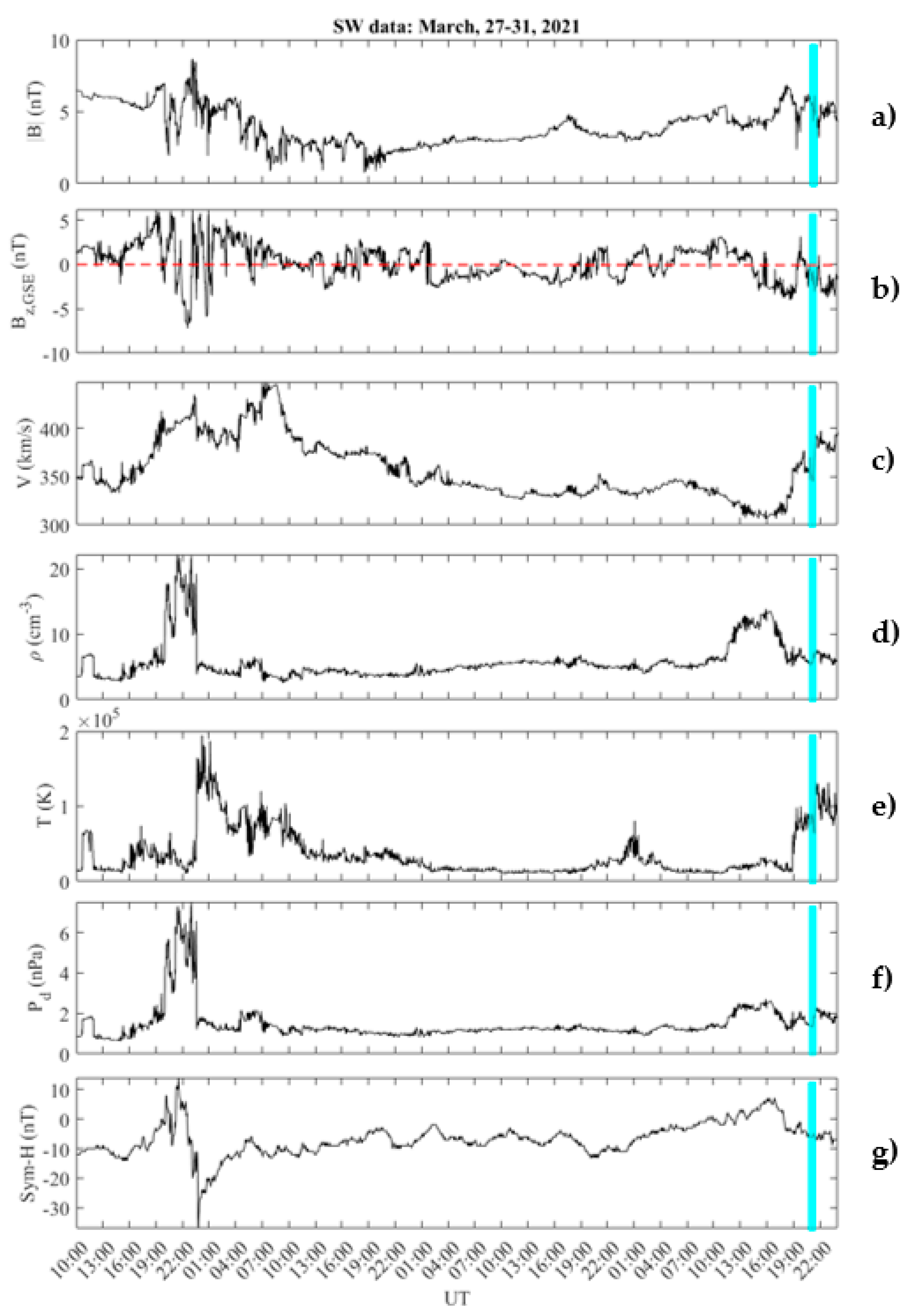
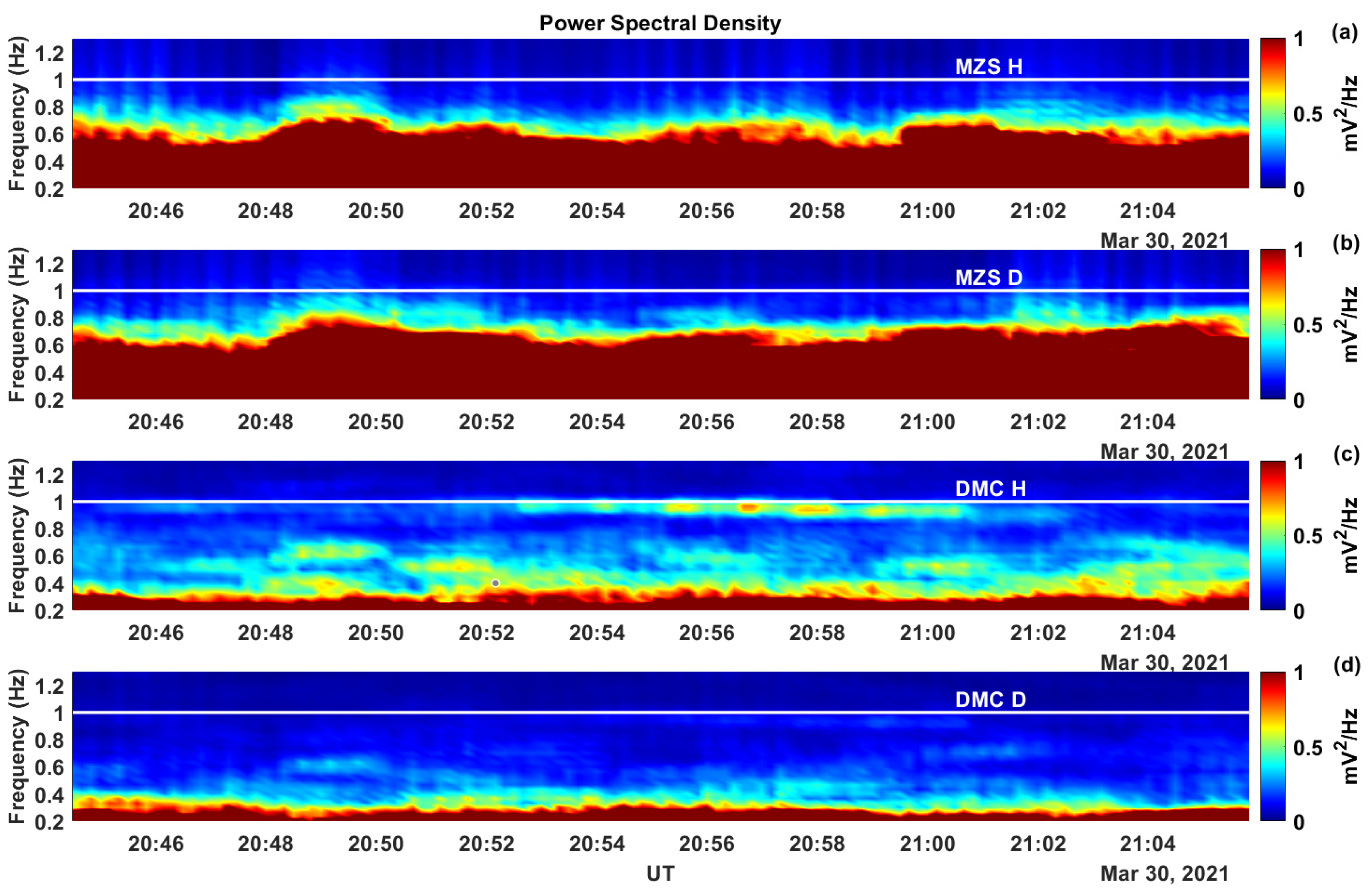
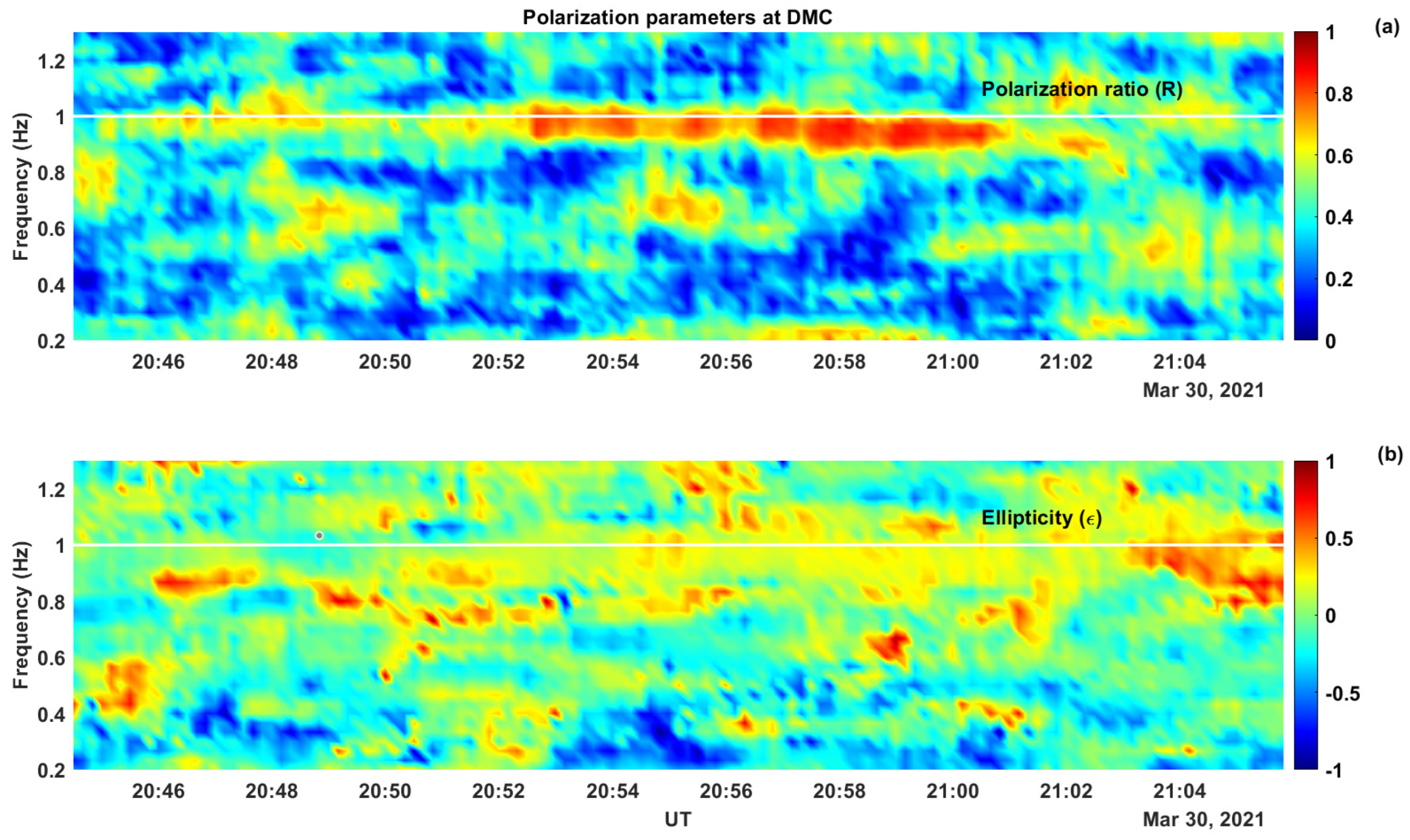
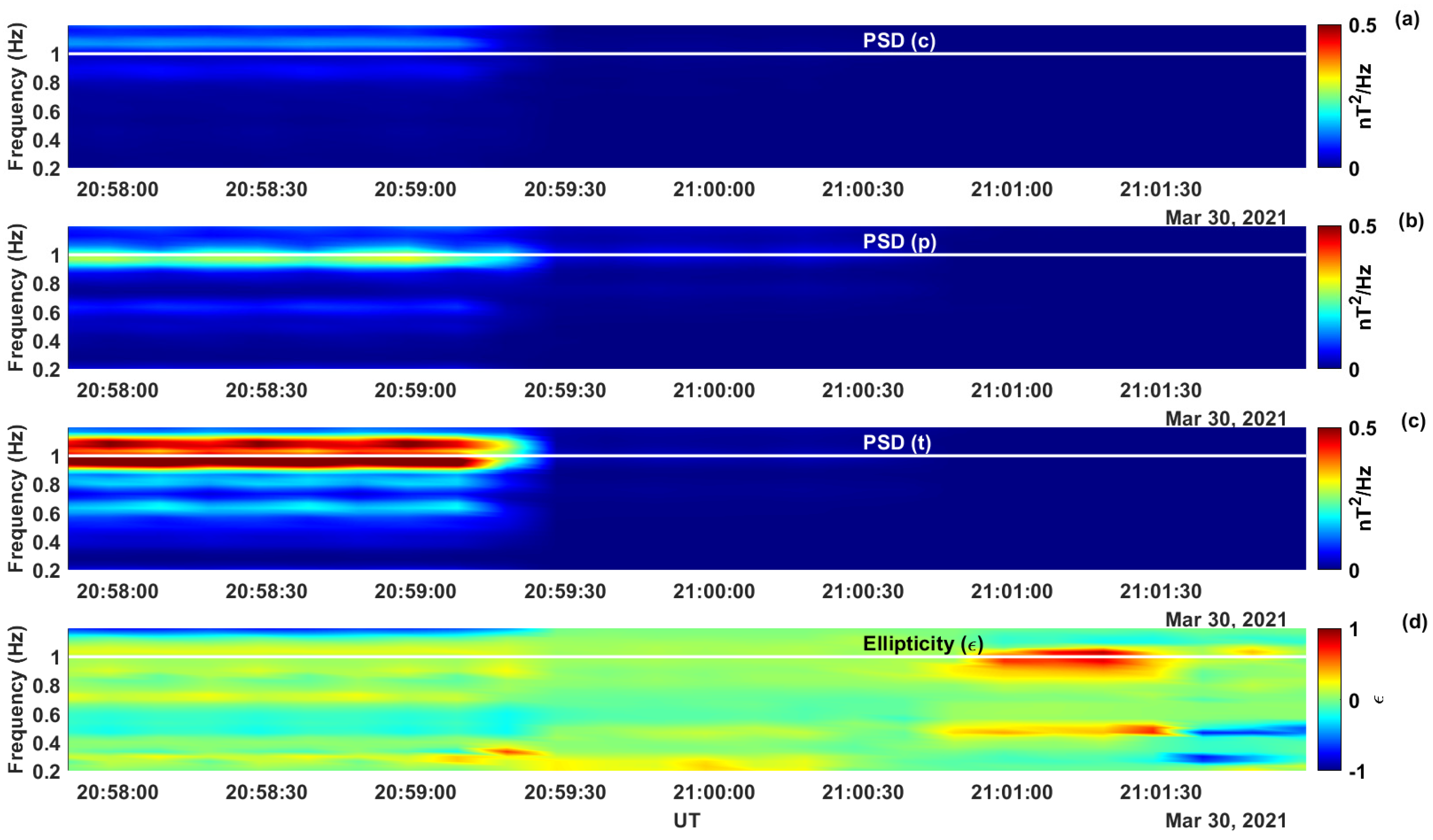
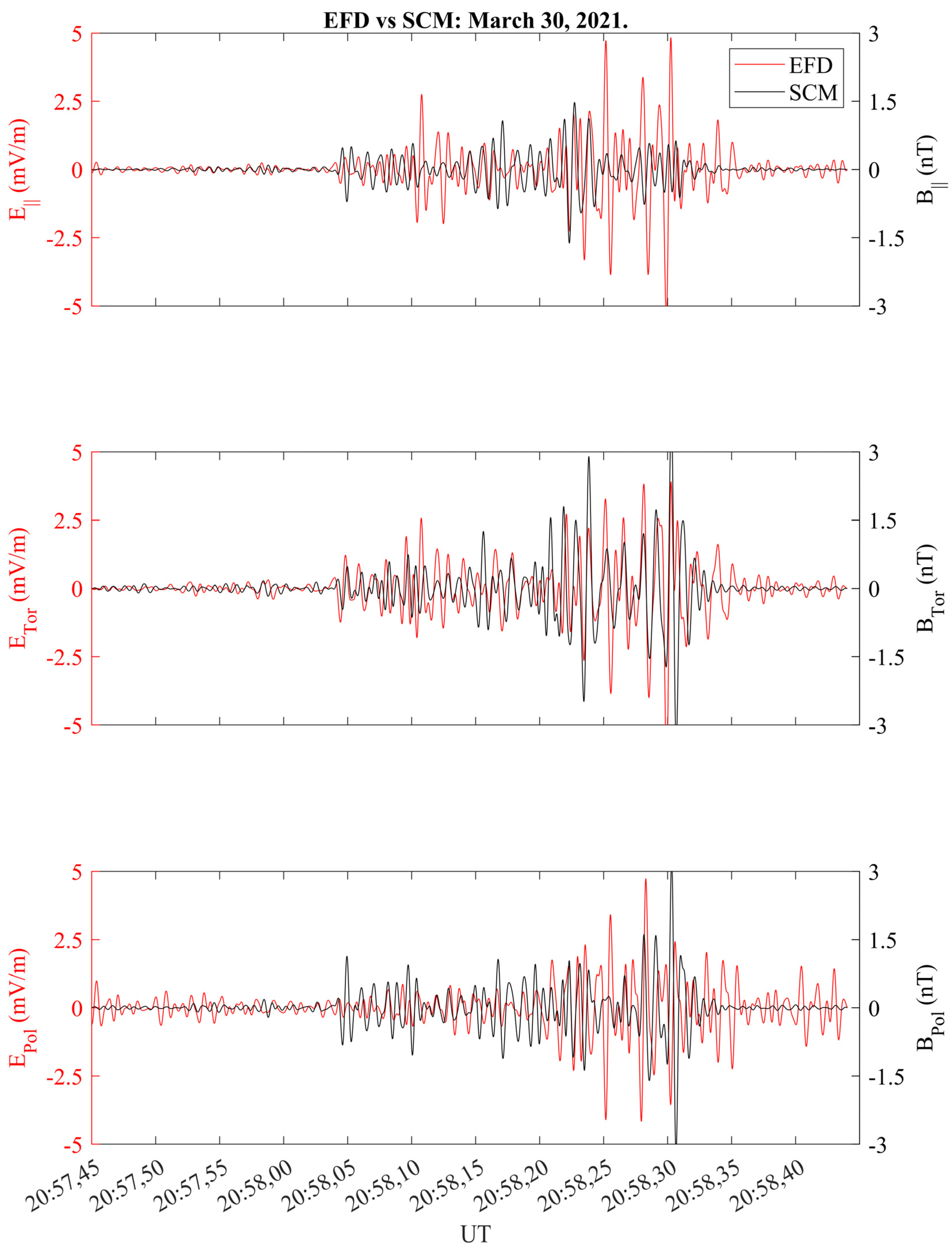
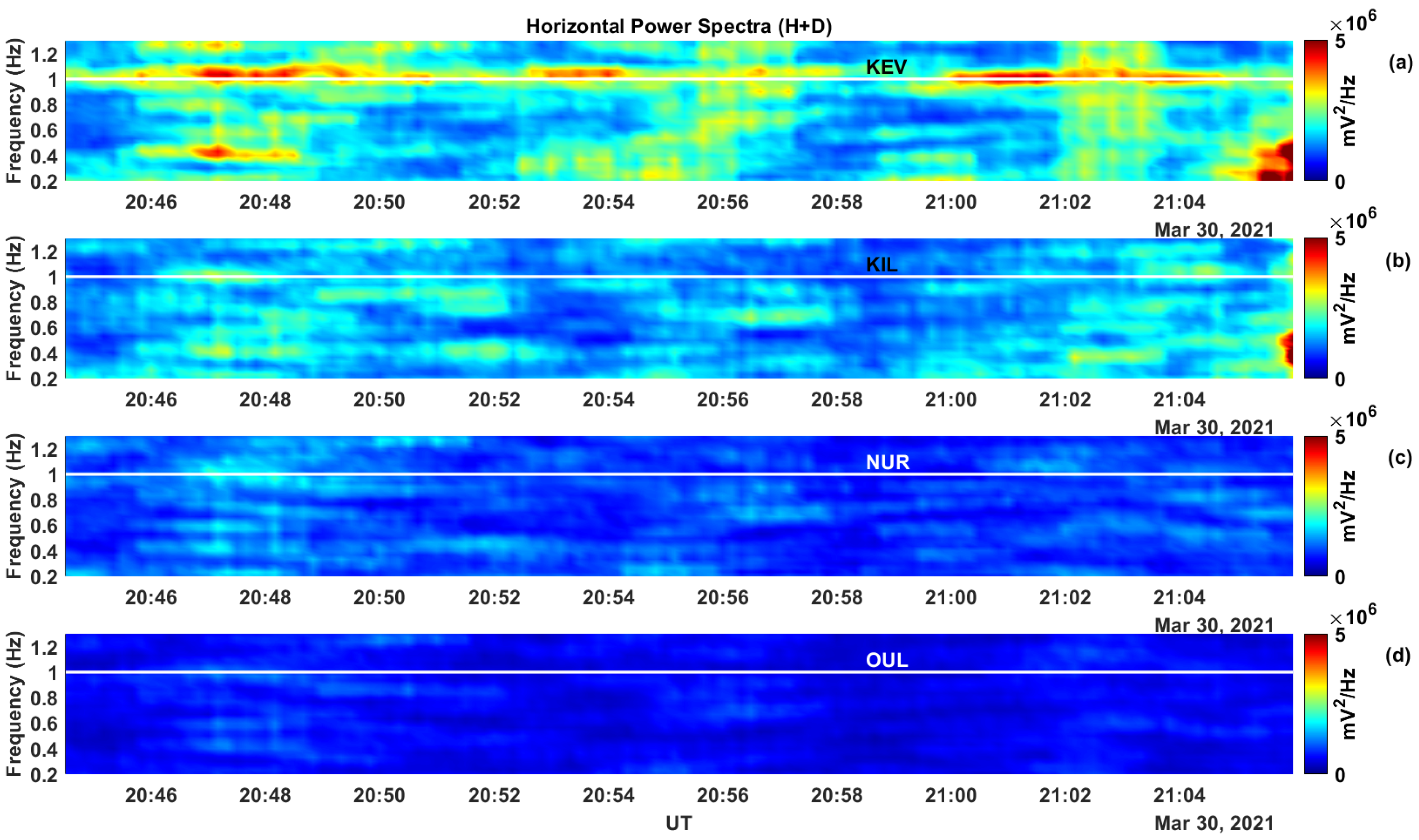

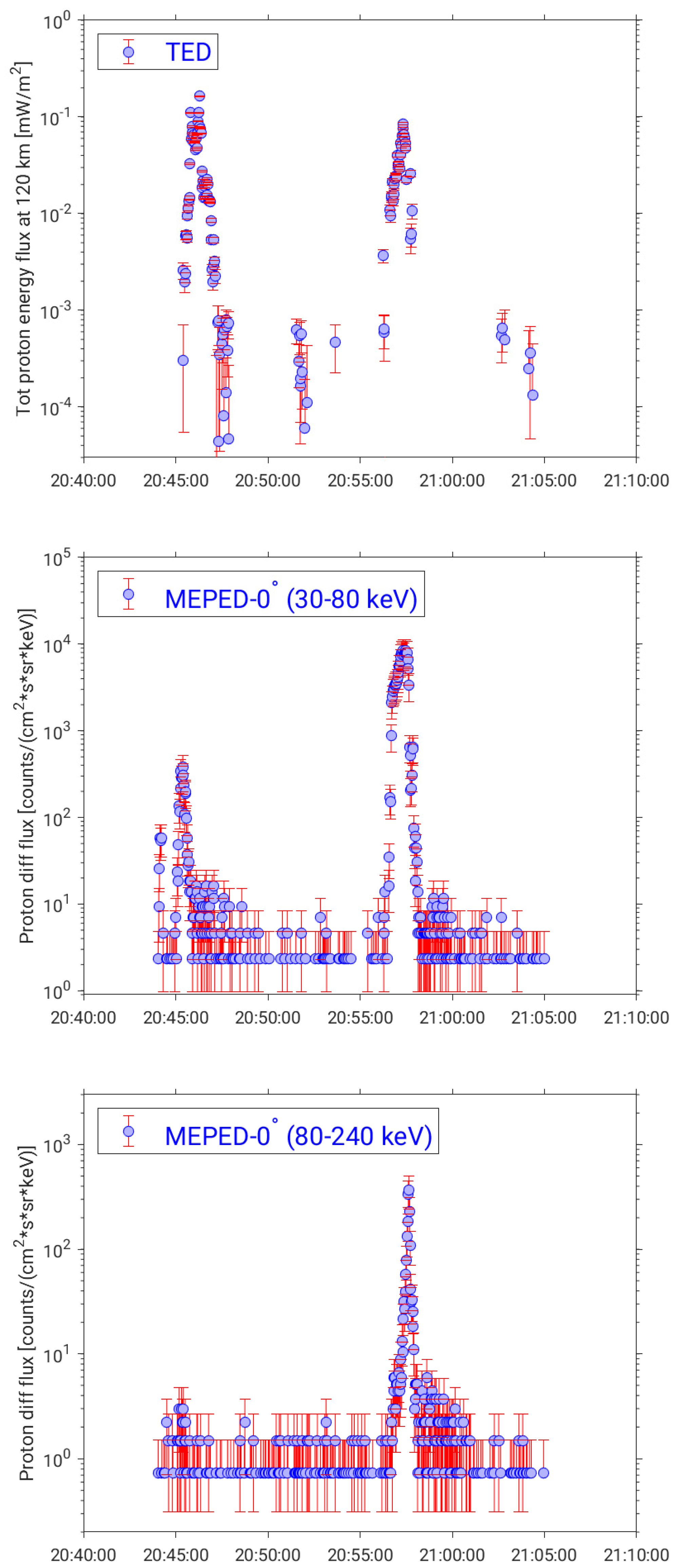
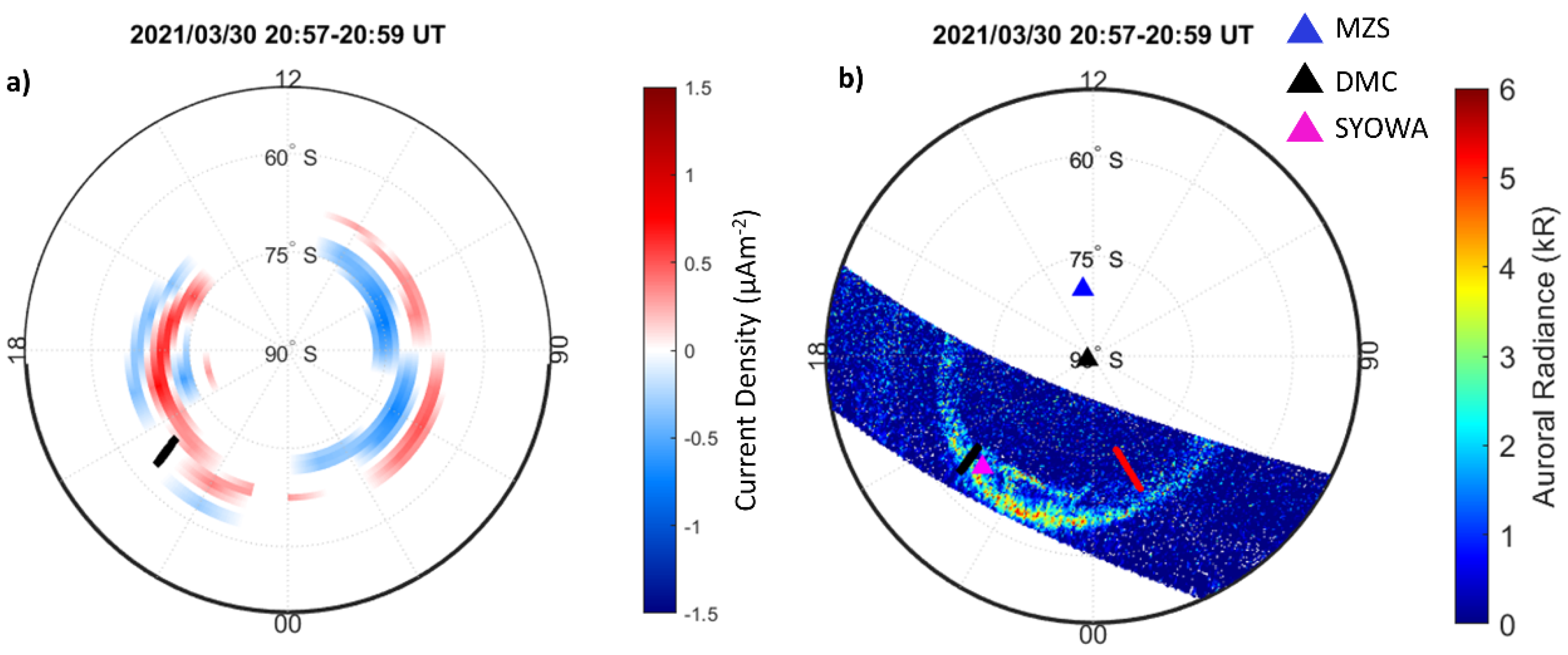

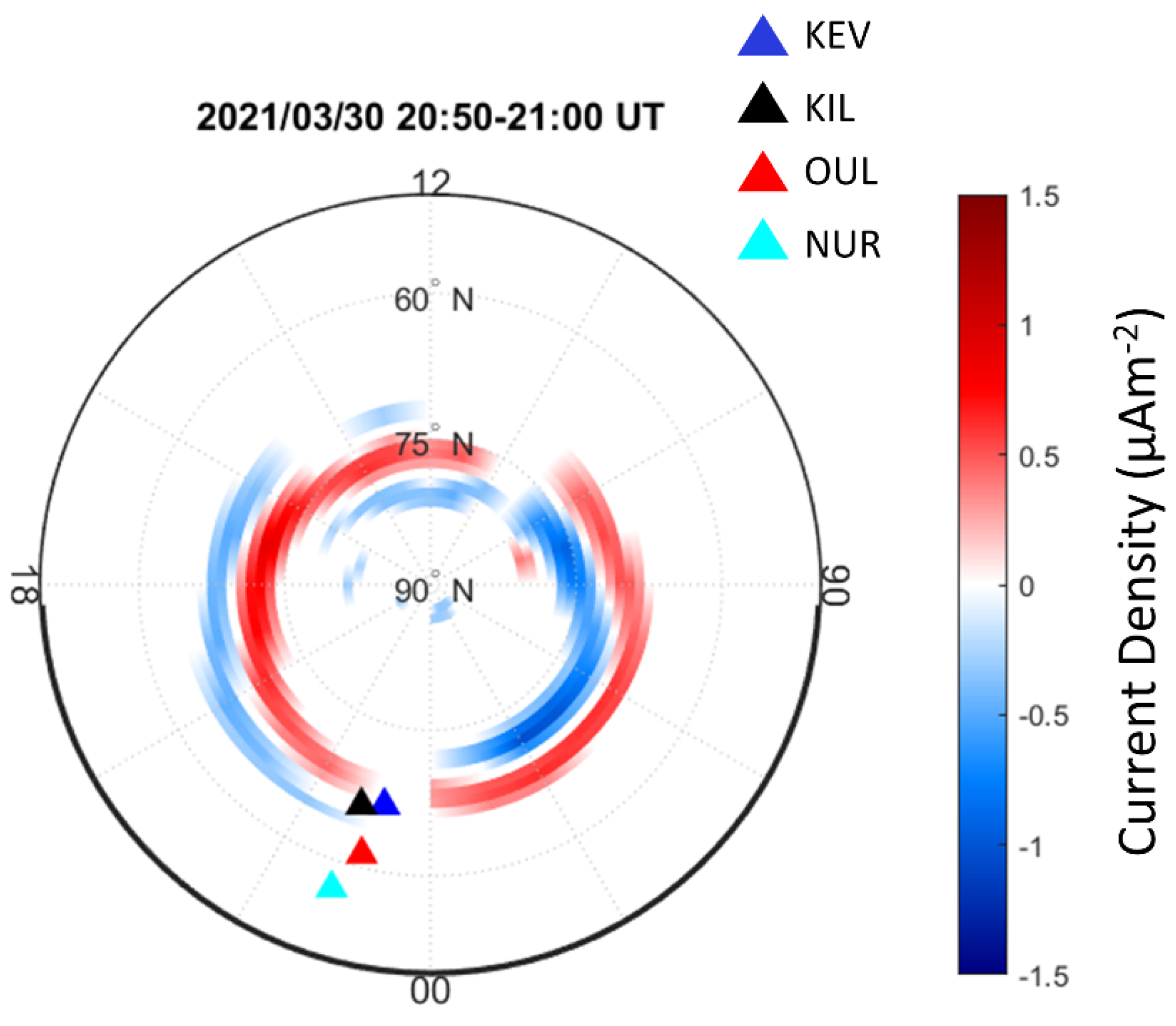

| Station | Station ID | Geographic Coordinates | Geomagnetic Coordinates | Local Time (LT) | Magnetic Local Time (MLT) |
|---|---|---|---|---|---|
| Mario Zucchelli | MZS | 74.69° S 164.12° E | 80.03° S 307.74° E | UT + 11 | UT-8 |
| Concordia | DMC | 75.11° S 123.40° E | 88.84° S 55.73° E | UT + 8 | UT-1 |
| Station | Station ID | Geographic Coordinates | Geomagnetic Coordinates | L Value | Magnetic Local Time (MLT) |
|---|---|---|---|---|---|
| Kevo | KEV | 69.75° N 27.02° E | 66.9° N 107.4° E | 6.6 | UT + 2:49 |
| Kilpisjärvi | KIL | 69.05° N 20.79° E | 66.4° N 101.8° E | 6.3 | UT + 2:26 |
| Oulu | OUL | 65.08° N 25.90° E | 62.1° N 103.9° E | 4.6 | UT + 2:36 |
| Nurmijärvi | NUR | 62.42° N 25.28° E | 59.4° N 102.3° E | 3.9 | UT + 2:29 |
Disclaimer/Publisher’s Note: The statements, opinions and data contained in all publications are solely those of the individual author(s) and contributor(s) and not of MDPI and/or the editor(s). MDPI and/or the editor(s) disclaim responsibility for any injury to people or property resulting from any ideas, methods, instructions or products referred to in the content. |
© 2024 by the authors. Licensee MDPI, Basel, Switzerland. This article is an open access article distributed under the terms and conditions of the Creative Commons Attribution (CC BY) license (https://creativecommons.org/licenses/by/4.0/).
Share and Cite
D’Angelo, G.; Francia, P.; De Lauretis, M.; Parmentier, A.; Raita, T.; Piersanti, M. A Case Study of Pc1 Waves Observed at the Polar Cap Associated with Proton Precipitation at Subauroral Latitudes. Atmosphere 2024, 15, 219. https://doi.org/10.3390/atmos15020219
D’Angelo G, Francia P, De Lauretis M, Parmentier A, Raita T, Piersanti M. A Case Study of Pc1 Waves Observed at the Polar Cap Associated with Proton Precipitation at Subauroral Latitudes. Atmosphere. 2024; 15(2):219. https://doi.org/10.3390/atmos15020219
Chicago/Turabian StyleD’Angelo, Giulia, Patrizia Francia, Marcello De Lauretis, Alexandra Parmentier, Tero Raita, and Mirko Piersanti. 2024. "A Case Study of Pc1 Waves Observed at the Polar Cap Associated with Proton Precipitation at Subauroral Latitudes" Atmosphere 15, no. 2: 219. https://doi.org/10.3390/atmos15020219
APA StyleD’Angelo, G., Francia, P., De Lauretis, M., Parmentier, A., Raita, T., & Piersanti, M. (2024). A Case Study of Pc1 Waves Observed at the Polar Cap Associated with Proton Precipitation at Subauroral Latitudes. Atmosphere, 15(2), 219. https://doi.org/10.3390/atmos15020219






